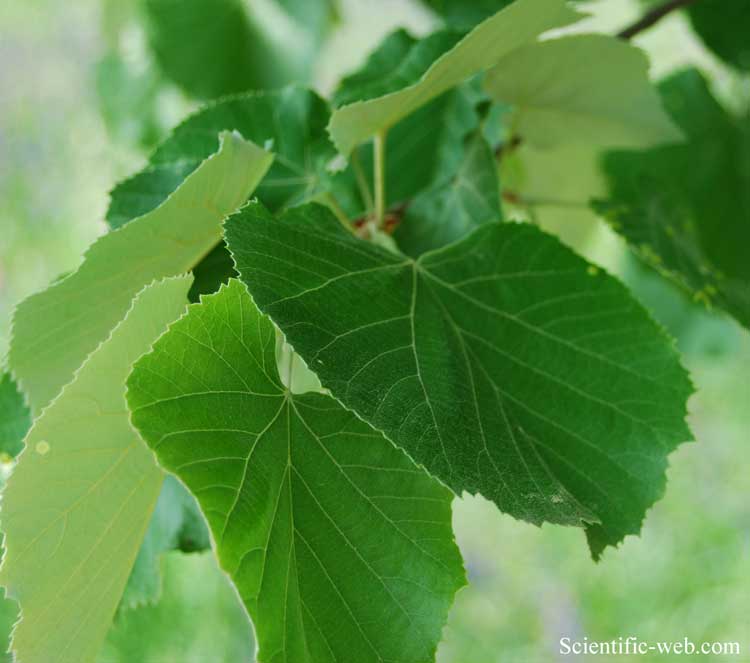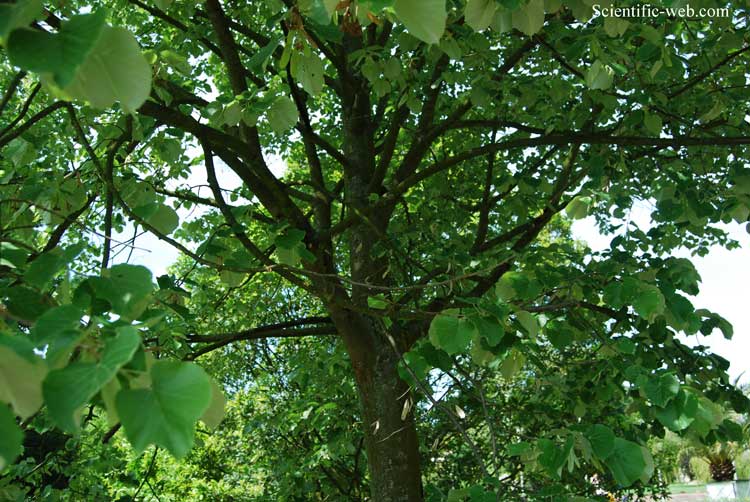
Tilia tomentosa , Photo: Michael Lahanas
Classification System: APG IV
Superregnum: Eukaryota
Regnum: Plantae
Cladus: Angiosperms
Cladus: Eudicots
Cladus: Core eudicots
Cladus: Rosids
Cladus: Eurosids II
Ordo: Malvales
Familia: Malvaceae
Subfamilia: Tilioideae
Genus: Tilia
Sectio: T. sect. Astrophilyra
Species: Tilia tomentosa
Name
Tilia tomentosa Moench, Verz. Ausländ. Bäume 136 (1785).
Synonyms
Heterotypic
Lindnera alba Fuss, Fl. Transsilv. 131 (1866).
Tilia alba Aiton, Hort. Kew. 2: 230 (1789).
Tilia argentea Desf. ex DC., Cat. Pl. Horti Monsp. 66, 150 (1813).
Tilia argentea f. subglobularis J.Wagner ex L.Z.Vöröss, Stud. Bot. Hung. 17: 71 (1984).
Tilia gigantea Dippel, Handb. Laubholzk. 3: 65. 67 (1893).
Tilia glauca Schwein. ex Bayer, Verh. Zool.-Bot. Ges. Wien, 12: 53 (1862).
Tilia heterophylla var. alba (Aiton) Wood, Fl. Atlantica 64 (1870).
Tilia macrophylla Steud., Nom. ed. II. 2: 687 (1841).
Tilia orbicularis V.Engl., Monogr. Gatt. Tilia, 121 (1909).
Tilia pallida Salisb., Prodr. Stirp. Chap. Allerton 367 (1796), nom. illeg.
Tilia peduncularis Delile ex Bayer, Verh, Zool.-Bot. Ges. Wien, 12: 58 (1862).
Tilia rotundifolia Vent., Anales Hist. Nat. 2(4): 64 (1800), nom. illeg. et nom. superfl. pro Tilia alba Aiton.
Tilia tomentosa var. rhodopetala Borbás
Distribution
Native distribution areas:
Europe
Middle Europe
Hungary.
Southeastern Europe
Albania, Bulgaria, Greece, Romania, Turkey-in-Europe, Yugoslavia (Bosnia-Herzegovina, Croatia, Kosovo, Macedonia, Montenegro, Serbia).
Eastern Europe
Ukraine (Moldova, Ukraine).
Asia-Temperate
Western Asia
East Aegean Islands, Turkey.
References: Brummitt, R.K. 2001. TDWG – World Geographical Scheme for Recording Plant Distributions, 2nd Edition

Tilia tomentosa , Photo: Michael Lahanas
References
Additional references
Davis, P.H. (ed.) 1967. Flora of Turkey and the East Aegean Islands. Vol. 2 (Portulacaceae to Celastraceae). Edinburgh University Press, Edinburgh, 581 pp. Reference page.
Tutin, T.G., Heywood, V.H., Burges, N.A., Moore, D.M., Valentine, D.H., Walters, S.M. & Webb, D.A. (eds.) 1968. Flora Europaea. Volume 2: Rosaceae to Umbelliferae. Cambridge University Press, Cambridge (UK), xxvii + 455 pp, ISBN 0-521-06662-X. Reference page.
Andreev, N., Ančev, M.E., Kožuharov, S.I., Markova, M.L., Peev, D.R. & Petrova, A.V. 1992. Opredelitel na visšite rastenija na Bălgarija [in Bulgarian]. 787 p. Nauka i izkustvo, Sofija. Reference page.
Musselman, L.J. 2011. Checklist of Plants of Lebanon and Syria. Old Dominion University, Norfolk, VA, 140 pp. PDF Reference page.
Danihelka, J., Chrtek Jr., J. & Kaplan, Z. 2012. Checklist of vascular plants of the Czech Republic. Preslia 84(3): 647–811. PDF Reference page.
Güner, A., Aslan, S., Ekim, T., Vural, M. & Babaç, M.T. (eds.) 2012. Türkiye Bitkileri Listesi (Damarlı Bitkiler). Nezahat Gökyiğit Botanik Bahçesi ve Flora Araştırmaları Derneği Yayını. İstanbul. ISBN 978-605-60425-7-7. Online edition. Reference page.
Pigott, C.D. 2012. Lime-trees and Basswoods: A Biological Monograph of the Genus Tilia. Cambridge etc.: Cambridge University Press, 405 pp., ISBN 978-0-521-84054-5. Reference page.
Dimopoulos, P., Raus, Th., Bergmeier, E., Constantinidis, Th., Iatroú, G., Kokkini, S., Strid, A. & Tzanoudakis, D. 2013. Vascular Plants of Greece: An Annotated Checklist. Englera 31: 1–368. Reference page.
Links
Hassler, M. 2020. Tilia tomentosa. World Plants: Synonymic Checklists of the Vascular Plants of the World In: Roskovh, Y., Abucay, L., Orrell, T., Nicolson, D., Bailly, N., Kirk, P., Bourgoin, T., DeWalt, R.E., Decock, W., De Wever, A., Nieukerken, E. van, Zarucchi, J. & Penev, L., eds. 2020. Species 2000 & ITIS Catalogue of Life. Published on the internet. Accessed: 2020 September 13. Reference page.
Govaerts, R. et al. 2020. Tilia tomentosa in Kew Science Plants of the World online. The Board of Trustees of the Royal Botanic Gardens, Kew. Published on the internet. Accessed: 2020 September 13. Reference page.
International Plant Names Index. 2020. Tilia tomentosa. Published online. Accessed: 13 September 2020.
Vernacular names
العربية: زيزفون لبدي
azərbaycanca: Gümüşü cökə
български: Сребролистна липа
čeština: Lípa stříbrná
dansk: Sølv-Lind
Deutsch: Silber-Linde
English: Silver Lime, silver linden
español: Tilo plateado, Tilo húngaro
euskara: Ezki ilauntsu
suomi: Hopealehmus
français: Tilleul argenté
galego: Tileiro prateado
hornjoserbsce: Slěborna lipa
magyar: Ezüst hárs
lietuvių: Sidabrinė liepa
Nederlands: Zilverlinde
norsk: Sølvlind
polski: Lipa srebrzysta
română: Tei argintiu
русский: Липа пушистая
svenska: Silverlind
Türkçe: Gümüşi ıhlamur
українська: Липа повстиста
Tiếng Việt: Đoạn lá bạc
中文: 銀毛椴
Tilia tomentosa, known as silver linden in the US[2] and silver lime in the UK, is a species of flowering plant in the family Malvaceae, native to southeastern Europe and southwestern Asia, from Romania and the Balkans east to western Turkey, occurring at moderate altitudes.[3][4]
Description
Tree in a public park in Belgium
Tilia tomentosa is a deciduous tree growing to 20–35 m (66–115 ft) tall, with a trunk up to 2 m (7 ft) in diameter. The leaves are alternately arranged, rounded to triangular-ovate, 4–13 cm long and broad with a 2.5–4 cm petiole, green and mostly hairless above, densely white tomentose with white hairs below, and with a coarsely toothed margin. The flowers are pale yellow, hermaphrodite, produced in cymes of three to ten in mid to late summer with a pale green subtending leafy bract; they have a strong scent and are pollinated by honeybees. The fruit is a dry nut-like drupe 8–10 mm long, downy, and slightly ribbed.[3][5]
Cultivation and uses
It is widely grown as an ornamental tree throughout Europe. The cultivar 'Brabant' has a strong central stem and a symmetrical conic crown. The cultivar 'Petiolaris' (pendent or weeping silver lime) differs in longer leaf petioles 4–8 cm long and drooping leaves; it is of unknown origin and usually sterile, and may be a hybrid with another Tilia species.[3][5] It is very tolerant of urban pollution, soil compaction, heat, and drought, and would be a good street tree in urban areas.[3][6] In cultivation in the UK, T. tomentosa 'Petiolaris' has gained the Royal Horticultural Society's Award of Garden Merit.[7][8]
An infusion made from the flowers of T. tomentosa is antispasmodic, diaphoretic and sedative.[9] This may be attributable to the presence of pharmacologically active ligands of benzodiazepine receptor.[10]
A widespread belief is that the nectar of this species contains mannose, which can be toxic to some bees. This is incorrect; the sight of numerous comatose bees found on the ground at flowering time is rather a result of the paucity of nectar sources in late summer in urban areas.[11]
This species, while fragrant in spring, drops buds and pollen during the spring and fall.
Notable trees
Eminescu's Linden Tree, Iaşi, Romania
Eminescu's Linden Tree (Romanian: Teiul lui Eminescu) is a 500-year-old silver lime situated in the Copou Public Garden, Iași, Romania. Mihai Eminescu reportedly wrote some of his best works underneath this silver lime, rendering the tree one of Romania's most important natural monuments and an Iași landmark.[12]
References
"Tilia tomentosa Moench". Plants of the World Online. Board of Trustees of the Royal Botanic Gardens, Kew. 2017. Retrieved 4 September 2020.
"Tilia tomentosa". Natural Resources Conservation Service PLANTS Database. USDA. Retrieved 10 December 2015.
Rushforth, K. (1999). Trees of Britain and Europe. Collins ISBN 0-00-220013-9.
Flora Europaea: Tilia tomentosa
Mitchell, A. F. (1974). A Field Guide to the Trees of Britain and Northern Europe. Collins ISBN 0-00-212035-6
Mitchell, A. F. (1996). Alan Mitchell's Trees of Britain. HarperCollins. ISBN 0-00-219972-6.
"RHS Plant Selector - Tilia petiolaris". Retrieved 15 April 2020.
"AGM Plants - Ornamental" (PDF). Royal Horticultural Society. July 2017. p. 102. Retrieved 23 December 2018.
Plants For A Future: Tilia tomentosa, which cites Lauriault, J. (1989). Identification Guide to the Trees of Canada. Fitzhenry and Whiteside, Ontario. ISBN 0-88902-564-9
Viola, H., Wolfman, C., Levi de Stein, M., et al. (1994). "Isolation of pharmacologically active benzodiazepine receptor ligands from Tilia tomentosa (Tiliaceae)". Journal of Ethnopharmacology. 44 (1): 47–53. doi:10.1016/0378-8741(94)90098-1. PMID 7990504.
Illies, Ingrid (2007). "The Foraging Behaviour of Honeybees and Bumblebees on Late Blooming Lime Trees". Entomologia generalis. Schweizerbart. Retrieved 6 June 2013.
Pettersen, L. & Baker, M. . Romania. Lonely Planet Travel Guide. p. 262.
Retrieved from "http://en.wikipedia.org/"
All text is available under the terms of the GNU Free Documentation License

